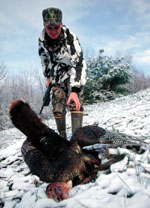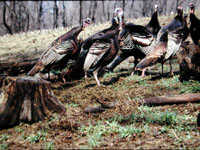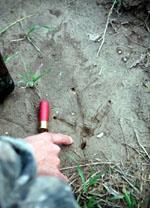
|
Features
|
|
|
|
Books
|
|
|
|
Fun & Games
|
|
|
|
Contact Us
|
|
|
John's Journal... Entry 168, Day 4
HOW TO HUNT FALL AND WINTER TURKEYS
How to Hunt Longbeards in the Fall
 EDITOR'S
NOTE: The birds of fall and the winter are both
the easiest and the hardest to take, depending on the lengths of their
beards and spurs. The longbeards of the fall are the most-difficult turkeys
to bag at any time of the year. But the jakes, the bird less than a year
old, are easy to take. The hunter's strategy for taking the turkeys of
fall and winter is completely different from the techniques he'll use
in the spring. Sex is no longer important to the gobblers. The birds already
have passed through their mating cycles, and the hens have made their
nests, laid their eggs and reared their young. Fall calling and hunting
tactics are based primarily on the social order of turkeys more than on
the sex drive of the birds.
EDITOR'S
NOTE: The birds of fall and the winter are both
the easiest and the hardest to take, depending on the lengths of their
beards and spurs. The longbeards of the fall are the most-difficult turkeys
to bag at any time of the year. But the jakes, the bird less than a year
old, are easy to take. The hunter's strategy for taking the turkeys of
fall and winter is completely different from the techniques he'll use
in the spring. Sex is no longer important to the gobblers. The birds already
have passed through their mating cycles, and the hens have made their
nests, laid their eggs and reared their young. Fall calling and hunting
tactics are based primarily on the social order of turkeys more than on
the sex drive of the birds.
 The
fall longbeard is the most difficult bird to bag, especially if he's an
old longbeard. A bachelor gobbler more than 2 years old that stays to
himself will test the mettle of any turkey hunter. Even the best turkey
hunters in the nation often walk off when this knight of the sharp spurs
throws down his gauntlet. In the fall, bachelor birds are very unpredictable,
often anti-social and difficult to hunt. Woodsmanship, more than any other
factor, is the key to taking a fall longbeard. To deliberately hunt a
turkey like this, you have to know him intimately -- where he lives, where
he feeds, where he roosts, and where he goes during the day. Generally
you have to learn all this information without hearing the bird talk.
Or, if the fall longbeard does make sounds, they'll be few. Patience will
be your strongest ally as you sit still for a long time and make very
few calls. You must realize when the bird does come in that the only sound
you'll hear may be his footsteps. Longbeards in the fall have personalities
and styles of living all their own. No general rules exist about how to
best hunt these birds. But if you will study a turkey and watch him without
his seeing you, he will teach you how to take him.
The
fall longbeard is the most difficult bird to bag, especially if he's an
old longbeard. A bachelor gobbler more than 2 years old that stays to
himself will test the mettle of any turkey hunter. Even the best turkey
hunters in the nation often walk off when this knight of the sharp spurs
throws down his gauntlet. In the fall, bachelor birds are very unpredictable,
often anti-social and difficult to hunt. Woodsmanship, more than any other
factor, is the key to taking a fall longbeard. To deliberately hunt a
turkey like this, you have to know him intimately -- where he lives, where
he feeds, where he roosts, and where he goes during the day. Generally
you have to learn all this information without hearing the bird talk.
Or, if the fall longbeard does make sounds, they'll be few. Patience will
be your strongest ally as you sit still for a long time and make very
few calls. You must realize when the bird does come in that the only sound
you'll hear may be his footsteps. Longbeards in the fall have personalities
and styles of living all their own. No general rules exist about how to
best hunt these birds. But if you will study a turkey and watch him without
his seeing you, he will teach you how to take him.
Bachelor Flocks of Longbeards
 Your
best chance for bagging a longbeard is to find a bachelor flock of birds,
sometimes called amigos, 2- and 3-year old birds that seem to prefer the
company of each other rather than a flock of hens. This bachelor band
may consist of three to 30 gobblers, depending on the turkey population
where you hunt. Turkeys are very social in nature. Often a bachelor flock
will remain together throughout much of the fall because they prefer one
another's company. However, the lure of running with the boys is in no
way stronger than their will to survive. Getting back together after they've
been scattered is not nearly as important to longbeards as it is to young
gobblers.
Your
best chance for bagging a longbeard is to find a bachelor flock of birds,
sometimes called amigos, 2- and 3-year old birds that seem to prefer the
company of each other rather than a flock of hens. This bachelor band
may consist of three to 30 gobblers, depending on the turkey population
where you hunt. Turkeys are very social in nature. Often a bachelor flock
will remain together throughout much of the fall because they prefer one
another's company. However, the lure of running with the boys is in no
way stronger than their will to survive. Getting back together after they've
been scattered is not nearly as important to longbeards as it is to young
gobblers.
To bag a longbeard in a bachelor band, you must scatter the flock in the same way you do the young turkeys. However, after the scatter, walk about 50 to 100 yards in the direction where you have seen several of the longbeards fly. Take a stand, and get comfortable. Wait 30 to 45 minutes before giving one to three coarse gobbler yelps, which are much more drawn out and more raspy than a hen's yelp. Once you've made that call, wait 45 minutes to an hour before you call again. Longbeards will be slow to group back together. Great patience and skill are required to call an amigo back to within gun range. Probably 50 percent of the time, none of the amigos will return. These birds have survived for at least two years because they are woods-wise and hunter-shy.
 Fall
longbeards in a flock can be called. However, you may have to sit in the
same spot and call for half of the day or three consecutive days to get
a shot. Generally if you're an experienced turkey hunter, have put in
hours scouting and are a very confident caller, you should be able to
bag a spring gobbler within three days. If you're an inexperienced hunter,
but have spent the time required to scout the area and already are a good
caller, plan on five days to two weeks to bag a fall gobbler. One tactic
a fall hunter will use is to try and locate a flock of longbeards in the
morning, scatter that flock, and then go somewhere else to hunt until
late afternoon. About 2:00 or 3:00 p.m., return to the site where you've
scattered the flock, sit down, and then begin to call to the longbeards.
If the turkeys fail to come in by dark, leave the area, go home, get a
good night's sleep, and return to that same spot at daylight the next
morning with your lunch packed. Then you can sit and call all day long.
Boredom is your biggest enemy when hunting the birds of fall. Patience
is your best ally. Determination most likely will prove to be your winning
strategy.
Fall
longbeards in a flock can be called. However, you may have to sit in the
same spot and call for half of the day or three consecutive days to get
a shot. Generally if you're an experienced turkey hunter, have put in
hours scouting and are a very confident caller, you should be able to
bag a spring gobbler within three days. If you're an inexperienced hunter,
but have spent the time required to scout the area and already are a good
caller, plan on five days to two weeks to bag a fall gobbler. One tactic
a fall hunter will use is to try and locate a flock of longbeards in the
morning, scatter that flock, and then go somewhere else to hunt until
late afternoon. About 2:00 or 3:00 p.m., return to the site where you've
scattered the flock, sit down, and then begin to call to the longbeards.
If the turkeys fail to come in by dark, leave the area, go home, get a
good night's sleep, and return to that same spot at daylight the next
morning with your lunch packed. Then you can sit and call all day long.
Boredom is your biggest enemy when hunting the birds of fall. Patience
is your best ally. Determination most likely will prove to be your winning
strategy.
If you take a fall amigo without ambushing him but by calling him, you deserve a trophy. Then you can pull your chair up to the table beside any of the nation's top turkey hunters. You've earned the right to be there.
TOMORROW: HOW TO HUNT THE LONE WOLVES OF FALL
Check back each day this week for more HOW TO HUNT FALL AND WINTER TURKEYS ...
Day 1 - How To Set Up on
Fall Gobblers
Day 2 - How to Hunt the Young Birds of Fall
Day 3 - How to Take Young Gobblers
Day 4 - How to Hunt Longbeards in the Fall
Day 5 - How to Hunt the Lone Wolves of Fall